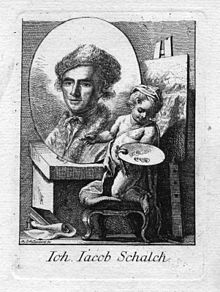Johann Jakob Schalch
Johann Jakob Schalch (born January 23, 1723 in Schaffhausen ; † August 21, 1789 there ) was a Swiss painter .
life and work
Johann Jakob Schalch was a student of Johann Ulrich Schnetzler in Schaffhausen and of the animal painter Karl Wilhelm de Hamilton in Augsburg . He traveled to Germany and France at a young age . In 1750 he married Maria Oechslin in Schaffhausen.
In 1754 he moved to London , where he soon rose to be a sought-after painter in the circles of the royal court. His specialties were animal and landscape paintings. Several of his paintings can still be found in the Royal Collection , the royal collection of paintings. These include The gardens at Kew and The White House, Kew .
In 1763 Johann Jakob Schalch moved to Holland . There he achieved his artistic breakthrough with the well-known equestrian image of the then English ambassador in The Hague . In 1773 he returned to Schaffhausen.
His famous Rhine Falls pictures, which were widely distributed through engravings, made his name known. Johann Jakob Schalch became increasingly blind in old age. He died in 1789 in his country house in the Durstgraben not far from the Rhine Falls.
The Schaffhausen Museum zu Allerheiligen has the largest collection of works by Johann Jakob Schalch.
literature
- Carl Brun: Swiss artist lexicon. Vol. 3 (1913), pp. 25 f.
- Johann Caspar Füssli : History of the best artists in Switzerland. Vol. 4, Zurich 1779, pp. 154–158.
- H. van Hall: Portraits of Dutch painters and other artists of the Low Countries. Amsterdam 1963.
- Barbara Schnetzler: Johann Jakob Schalch . In: Schaffhauser Contributions to History. Biographies Volume IV . 58th year 1981, pp. 266–268 ( PDF )
Web links
- Werner Rutishauser: Schalch, Johann (Jan) Jakob (Jacob). In: Sikart
- Pictures by Johann Jakob Schalch in the electronic gallery of the Royal Collection
- A picture of the Rhine Falls by Johann Jakob Schalch in the Museum zu Allerheiligen
Individual evidence
- ↑ Six were destroyed in the Schaffhausen bombing . See Andreas Rüfenacht: The destroyed art department and the consequences of their destruction as well as catalog of the destroyed works, in: Museum zu Allerheiligen (Hrsg.): Art from rubble. The bombing of the All Saints Museum in 1944 and its consequences , Baden 2019, ISBN 978-3-03919-489-6 .
| personal data | |
|---|---|
| SURNAME | Schalch, Johann Jakob |
| BRIEF DESCRIPTION | Swiss painter |
| DATE OF BIRTH | January 23, 1723 |
| PLACE OF BIRTH | Schaffhausen |
| DATE OF DEATH | August 21, 1789 |
| Place of death | Schaffhausen |

